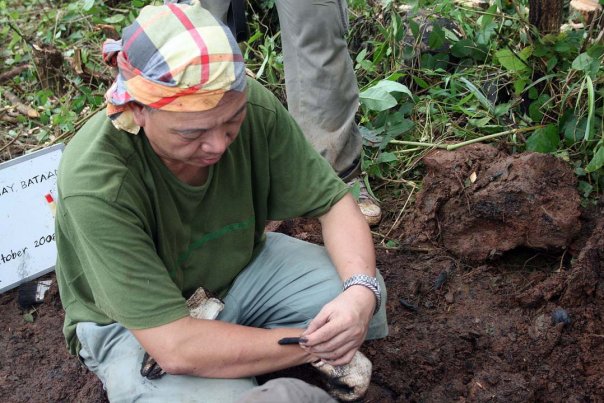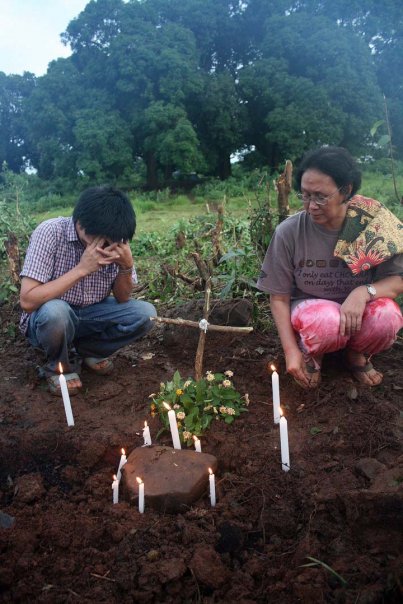This article is republished in light of the conviction of retired Philippine Army Major General Jovito S. Palparan by the Branch 15 of the Malolos Regional Trial Court yesterday for the kidnapping and serious illegal detention of missing University of the Philippines students Sherlyn Cadapan and Karen Empeno. The testimony of prosecution witness Raymond Manalo contained in this article was given due consideration and weight by the court that finally convicted Palparan, long-known as “The Butcher” by his victims and the human rights community.
This report was originally published by Bulatlat.com on October 18, 2008.
= = = =
By Raymund B. Villanueva
On March 22, 2007, Shara Hizarsa was waiting for her father Abner to bring lunch to school she would later share with him. He had cooked and brought food for her without fail since he left the underground revolutionary movement due to frail health.
But no one arrived for the girl’s lunch that day.
It had been 19 months since. There is still no father to cook and bring food for Shara.
Last October 13, Shara commemorated her 12th birthday. Even her mother Cris cannot be with her on her special day because she had to join dozens of relatives of the forcibly disappeared under the Gloria Macapagal-Arroyo regime in a fact-finding mission in Barangay Bliss, Limay, Bataan.
Horror camp
In an abandoned military camp near the World War II monument in Mount Samat, about 50 human rights workers under Karapatan and Desaperacidos, the victims’ relatives, officials and staff of the Commission on Human Rights (CHR) and University of the Philippines (UP) anthropologists led by Dr. Francisco Datar dug holes on the ground, hoping to find remains of summary execution victims. They were led to the site by Raymond Manalo, one of two brothers who escaped from the custody of the 24th Infantry Battalion of the 7th Infantry Division of the Philippine Army.
Manalo said that he and his brother Reynaldo were taken to the camp on November 21 or 22, 2006. A week later, he saw missing UP student Karen Empeño and farmer Manuel Merino. They were later joined by Sherlyn Cadapan, another abducted UP student.
Inside the camp, Raymond was ordered to help build the barracks, cook and clean house for the soldiers, led by a certain Maj. Donald “Allan” Caigas. He witnessed how the two students were hung upside down on one foot with sticks repeatedly rammed into their private parts. After each torture session on the women, Raymond was ordered to clean the room of the victims’ blood and faeces and even wash their underwear. He recalled of many nights he went to sleep with blood-curdling screams ringing in his ears.
Raymond also recounted in his affidavit that he, his brother Reynaldo and Merino were taken to “cattle-rustling and harassment missions” by the soldiers led by Caigas. He witnessed the execution and abduction of farmers in outlying villages.
One night in June 2007, soldiers took Merino from their holding room, saying then Maj. Gen. Jovito Palparan wanted to talk to him. Several minutes later, he saw Merino being marched to a grassy field 50 meters away from the camp’s barbed-wire perimeter. Standing by a window, Manalo heard screams and moans, like someone who was startled (“Parang nagulat.”), followed by two gunshots. “Siguro hindi nadale sa saksak, kaya binaril,” he said. (“They probably failed to kill him by stabbing so they shot him.”) Then he saw what looked like a bonfire that lasted late into the night. The next morning, he was told not to look for Merino as he has already “joined” Cadapan and Empeño. “Pinatay si ‘Tay Manuel dahil sabi ng militar matanda na siya,” Raymond added. (“Manuel was killed because the military said he was already old.”)

A diorama exhibited at the House of Representatives based on Raymond Manalo’s description of the military camp. (Diorama by Ron Magbuhos Papag)
In July 2007, the Manalo brothers were taken to Caigas’ farm in Bolinao, Pangasinan to work as laborers where they escaped on the night of August 12, 2007.
‘Clear and convincing’ testimony
The government and army’s top officials took turns belying Raymond’s testimony by denying the existence of the camp. Defense Secretary Gilbert Teodoro and retired Armed Forces Chief of Staff Hermogenes Esperon said that Manalo’s testimony was “baseless.” Lt. Gen. Isagani Cachuela, PA Northern Luzon commanding general, said that he would not know about the existence of the camp in Barangay Bliss. Maj. Gen. Ralph Villanueva, 7th ID commander, which has jurisdiction over the 24th IB, echoed Cachuela’s statement saying he “still has to find out.”
Last September 20, PA spokesperson Lt. Col. Romeo Brawner also issued a statement saying Cadapan, Empeno and Merino were nowhere to be found in any army camp where their relatives and supporters claimed they were detained.
But residents of Barangay Bliss are one in saying that there indeed was a military camp in their village. The Philippine Daily Inquirer also reported that former Bataan vice governor Rogelio Roque confirmed that the military used to occupy the area, which is adjacent to his property.
Despite the military’s denials, Raymond’s testimony was considered by the Court of Appeals and the Supreme Court (SC) as “factual,” “harrowing” as well as “clear and convincing.” Last October 6, the SC affirmed the Appellate Court’s decision to grant the privilege of the Writ of Amparo to the Manalo brothers, providing them protection from State forces. The order also affirmed the possible culpability of Palparan in their abduction and torture, as well as that of Cadapan, Empeño, Merino and others. The SC also rejected the 7th ID’s investigation as “very limited, superficial and one-sided.”
CHR chair Leila de Lima, for her part said, “The Manalo brothers, for me, have the most significant testimony in the extralegal killings and enforced disappearances.”
‘I will prove to them I am right’
A week after being granted the privilege of the Writ of Amparo, Raymond led the fact-finding mission to the military camp. Before the sun rose, Raymond had already identified the camp layout while other mission members set up tents and cordoned areas where the possible grave sites were.
According to their observations, there was painstaking effort to erase the camp’s footprint in the area. The concrete hut floors, the basketball court, the flag pole as well as the Marian grotto were broken up and thrown in a clump of bamboo trees about 100 meters away. All the holes were backfilled and the water pipes removed. Still, amid the shrubbery and the wildflowers that overrun the abandoned camp and under the sprawling shades of the dozen huge mango trees that blanketed the area, Raymond managed to identify the spot of every structure that stood in the military camp.

Raymond Manalo describing the camp layout.
“Hindi ko aakalaing babalik pa ako rito. Takot ako, nanginginig, giniginaw. ‘Nung una kaming dinala rito, akala namin ay isa-salvage na kami,” Raymond said. (“I never thought I would come back here. I am afraid, shaking, and I feel cold. When we were first taken here, we thought we would already be summarily executed.”)
By the time the CHR team arrived by mid-morning, the mission was ready to dig and document whatever could be found in the area.
At noontime, De Lima arrived from Manila and conducted an ocular inspection of the possible gravesites. She also ordered additional diggers to complement the Karapatan team who found the stony soil difficult to penetrate beyond a foot and a half.
The first four holes in three possible gravesites produced negative results. But there were signs of unusual human activity such as burnt tarpaulins, tabletop covers, shoes, among others. Raymond identified one shirt that might have belonged to Cadapan. The anthropologists also confirmed that some of the spots pinpointed by Raymond bore “disturbances” by human activity.
As dusk neared on the mission’s first day, a fifth hole was dug which the experts said was “promising” as the soil was still soft and comparatively loose past two feet. It was then that the experts ordered a halt to the diggings on account of the approaching darkness.
Night falls on the mission camp
Under the pale light thrown by old-fashioned “petromax” lamps, the remaining 30 or so human rights workers ate dinner while a squad of Philippine National Police-Regional Mobile Group troopers kept a somewhat loose perimeter security. Before dinner was over heavy rains fell on the camp, overturning tents and soaking both mission members and their clothing and equipment. The victims’ relatives bussed back to Manila due to security considerations, along with some Manila-based journalists. Only then did the CHR-sourced generator arrive from the town proper to provide electricity.
By 7 pm, when the rain stopped, the mission members slept with their wet clothes and soaked sleeping provisions. The generator was turned off an hour later and the last mobile phone calls and text messages were sent. Even the police retreated inside their tents and vehicles.
Breakthrough
The mission’s second day started with a briefing between the CHR, UP and Karapatan teams. Datar expressed confidence that if Raymond was telling the truth, they would find human remains such as small bones of the hand and feet. “These are the things that betray the perpetrators of the crime,” he said.
But that morning provided more disappointments. Site Three was abandoned after it produced no convincing evidence. A new site was opened in the hope of more positive results. Datar interviewed Raymond several times and asked him to walk from the camp’s edge to where he thought Merino was taken at least four times. Raymond also informed the expert that he remembers Merino was wearing an old pair of yellow “Beach Walk” flip-flops. Assured that Raymond was certain about his coordinates and facts, Datar ordered the widening of Site One.
While standing on the edge of the camp Raymond found clothing on the ground, nearly covered with soil. When he picked it up, he identified it to have belonged to Caigas. “Shorts ito ni Caigas. ‘Basic Wear’ ang tatak. Siya lang ang meron nito—pantulog niya,” he said. (These are Caigas’ ‘Basic Wear’ brand short pants. Only he had them—as sleepwear.”) He said he was certain because he washed the soldiers’ dirty laundry.
At exactly 12:30 pm, anticipation gripped team members on Site One. What was thought to be just a layer of burnt wood close to the surface yielded a four-centimeter splinter, which Datar immediately identified as a human bone. He then ordered a wider surface scraping of the site. Before the team decided to take a delayed lunch break the hole already produced 15 more bone pieces.

Dr. Datar shows what kind of bone fragment was found on the site.
When digging resumed more bones were found on the burnt-out hole. At 3:45 pm, Datar’s graduate assistant struck another vital piece of evidence—an overturned slipper found on the edge of the small cavity with yellow straps and bearing the brand name “Beach Walk.” When Raymond saw the article, he exclaimed “’Yan ‘yun! Kay ‘Tay Manuel! ‘Yan ‘yun!” (That’s it! That’s old man Manuel’s. That’s it!) Datar then said, “Positive na tayo.” (“We are already positive about this grave site.”) A few minutes later a simple ring band was also found as well as a human vertebra.
At 5 pm, the digging and scraping has reached the hole’s edge. Datar said that, based on the materials gathered and examined by the UP, CHR and Karapatan experts on the site, firewood and rubber tires were placed at the hole’s bottom before the victim was placed in a fetal position wrapped in a mattress. “These foreign objects and the victim’s position explain why the hole is relatively small,” he said. Datar added that the gravesite was covered with un-burnt soil in the perpetrators’ efforts to conceal the spot.
Datar however hastened to add that it would be impossible to extract DNA from the “carbonized” bones. He also said that he still has to study the specimens in the laboratory to ascertain which parts of the body the bones came from.
Strong proof
Still, Datar commended Raymond’s fortitude. “May lakas siya ng loob na sabihin (ang nalalaman),” he said. (“He was courageous to speak out.”). “It was clear there were human activities in the areas he pointed out,” Datar added.
“Nabuhayan ako ng loob,” Raymond said. “Kung wala tayong nakita e di lalo na nilang sasabihing sinungaling ako,” he added. (“I had a morale boost. If we found nothing here, the military will say I lied all the more.”)
Raymond’s legal counsel Rex JMA Fernandez is optimistic about the results of the fact-finding mission. “What Raymond said (about their abduction and killings) was proven today. Moreover, there was deliberate purpose to sanitize the burial place. If you take a closer look, the camp was big. It was not cursory but a protracted occupation of the place (by the military). That Palparan was involved in the tortures would be validated by these findings. Even if the military would try to undermine the results of this mission, Raymond is a very credible witness,” the lawyer explained.
Fernandez added that he wants the area declared a crime site. “I think they should continue digging and investigating. They should also interview the locals,” he said.
The mission ends, the quest for justice continues
Cris Hizarsa summed it up for the relatives. “Katulad ng ibang mga pamilyang naghahanap, umaasa akong hindi kasama ang asawa ko sa mga pinatay dito. Yun ang pag-asa ko at ng mga anak ko. Sana, yun ang regalong maiuuwi ko sa kaarawan ni Shara.” (“Like the other relatives of the victims, my family and I hope my husband was not one of those killed here. I hope that is the news I bring home to my daughter Shara for her birthday.”)

Manalo breaks down at the spot where Manuel Merino was murdered by Philippine Army soldiers under the command of Gen. Palparan.
Before dusk of the second day, all the holes were backfilled as the mission camp was being dismantled. Raymond Manalo then walked one last time to the gravesite, accompanied by the Karapatan team and Dr Datar. The CHR team chose not to join them. Fr. Dionito Cabillas led the prayers while the mission members joined hands around the makeshift grave. After the prayers, shouts of “Justice!” rang several times.
Then everyone broke down. Copious tears flowed on Raymond’s scarred face, his shoulders askew in physical and emotional pain. The chests of relatives of the forcibly disappeared heaved in grief while Datar’s own eyes were moist and red.
As the sun was setting behind Mt Samat the mission members walked away from the grave now looking more desolate with the weak flicker of candles amid the creeping darkness. Finally, Raymond turned his back on the site where Manuel Merino was killed, leaving the wild flowers to bloom in a land that has seen such horror finally coming to light. # (More photos of the fact-finding mission here.)




